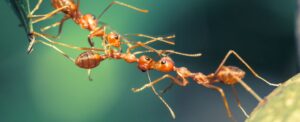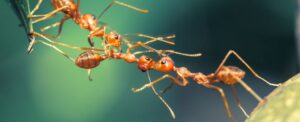
A recent study published in Current Biology reveals that weaver ants, specifically the species Oecophylla smaragdina, demonstrate a unique ability to work together effectively, countering a phenomenon known as the Ringelmann effect. This effect, first identified by French engineer Max Ringelmann in the late 19th century, suggests that as group size increases, individual performance tends to decline. Researchers sought to determine whether weaver ants could overcome this limitation in their cooperative efforts.
Weaver ants are well-known for their exceptional collective action, often seen crafting elaborate nests by pulling together living leaves and binding them with silk from their larvae. The study, led by Chris R. Reid from Macquarie University and Daniele Carlesso from the Max Planck Institute of Animal Behavior, investigated how these ants form “pulling chains” to perform tasks. Each ant grips the waist of another with its jaws, allowing them to pull in unison.
To assess the efficiency of these chains, the researchers designed an experiment where the ants were encouraged to pull an artificial paper leaf attached to a force meter. As the number of ants participating in the task varied, the team monitored changes in their collective force output in real time. Contrary to their initial hypothesis, which suggested that individual force would decrease with larger groups, the results indicated that not only did the total pulling force increase, but so did the force exerted by each individual ant.
This surprising finding suggests that weaver ants are “superefficient” in their teamwork, an ability that sets them apart from many other species. The researchers found that the ants performed best when arranged in a single, elongated chain rather than in shorter segments. This arrangement facilitated a division of labor, with ants at the rear adopting a posture that helped them resist the counter-force of the leaf, while those at the front engaged in active pulling.
The study introduces a concept termed the “force ratchet,” which posits that the weakest link in these pulling chains is not the connections between the ants but their grip on the ground. When pulling alone, an ant’s maximum force is limited by the risk of slipping. However, in a chain formation, the rear ants can act as passive resistors, enhancing stability and enabling front ants to exert greater force.
The implications of this research extend beyond the world of ants. The findings could inform advances in the field of autonomous robotics, particularly in swarm robotics, where small, inexpensive robots are designed to collaborate on tasks. Current robot teams typically achieve linear scaling—doubling the number of robots doubles the output force—but do not exhibit the same superefficiency observed in weaver ants.
Future experiments will further explore variations in ground slipperiness and leaf weight to validate the force ratchet hypothesis. This research challenges the assumption that larger groups inevitably lead to diminished individual effort, suggesting that for certain species, including weaver ants, teamwork can indeed yield greater collective effectiveness.
As the study concludes, it emphasizes a fundamental lesson about collaboration: sometimes, more truly is better. In the realm of ants, if they were culinary experts, they would likely create the finest broth through their remarkable teamwork.






